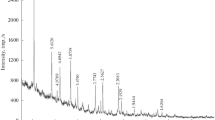Abstract
Residues from the evaporation of pure or mixed solutions of Ca(HCO3)2 and Mg(HCO3)2 were subjected to investigation by DTA (N2 or CO2 atmosphere), TG, EGA, X-ray and classical chemical analysis. The Ca/Mg atomic ratio exerted a great effect on EGA and DTA peaks between 400 and 500°. Peak temperatures were the lowest when 1.2 < Ca/Mg < 1.33. When Ca/Mg < 1.25, CaCO3 exists only as aragonite. When Ca/Mg > 1.25, calcite progressively replaces aragonite, but never entirely. Investigations are continuing.
Résumé
Des résidus d'évaporation de solutions pures ou mixtes de Ca(HCO3)2 et Mg(HCO3)2 ont été étudiés par ATD (atmosphère N2 ou CO2), ATG, AGE, rayons X et analyse classique. La valeur du rapport atomique Ca/Mg a une influence considérable sur la manifestation des accidents thermiques compris entre 400 et 500°. Pour 1.2 <Ca/Mg < 1.33, les pics sont décalés vers des températures plus basses. Pour Ca/Mg < 1.25, CaCO3 est sous forme d'aragonite. Pour Ca/Mg > 1.25, la calcite se substitue progressivement à l'aragonite, mais pas totalement. L'étude se poursuit afin de dégager d'autres conclusions.
Zusammenfassung
Die Verdampfungsrückstände reiner Lösungen bzw. Gemische von Ca(HCO3)2 und Mg(HCO3)2 wurden mittels DTA (in N2- oder CO2-Atmosphäre), TGA, EGA, Röntgenstrahlung und klassischer Analyse untersucht. Der Wert des Atomverhältnisses Ca/Mg hat einen bedeutenden Einfluß auf die thermischen Vorgänge zwischen 400° und 500°. Bei 1.2 < Ca/Mg < 1.33 werden die Spitzen in Richtung der niederen Temperaturen verschoben. Bei Ca/Mg < 1.25 befindet sich das CaCO3 in der Aragonitform. Bei Ca/Mg > 1.25 wird Aragonit fortschreitend, jedoch nicht vollständig durch Calcit ersetzt. Die Versuche werden fortgesetzt, um weitere Aussagen zu ermöglichen.
Резюме
Осадки, образовавшие при испарении чистых или смешанных растворов Cа(НСО3)2 и Mg (НСО3)2, исслед ованы методами ДТА (в атмосфере N2 или СО2) ТГ А, рентгеноструктурно го анализа, анализа вы деляющихся газов (ВГА) и классичес кого химического анализа. Атомное отношение Ca/Mg о казывает значительное влияни е на пики ТГА и ДТА в области тем ператур 400–500°. Температ уры пиков наиболее низки при 1.2 < Ca/Mg < 1.33. Если Ca/Mg < 1,25, СаСО3 прису тствует только в виде арагонита. Если Ca/Mg > 1.25, кальцит посте пенно замещает араго нит, но до конца этот процесс не идет. Исследования пр одолжаются с целью вы яснения проблемы.
Similar content being viewed by others
Bibliographie
K. H. Wolf, G. V. Chilingar etF. W. Beales, dans “Carbonate Rocks”, p. 24. Editeurs: G. V. Chilingar, H. J. Bissell et R. W. Fairbridge, Elsevier Publishing Company, Amsterdam, 1967.
M.Vanthournhout, Tribune de Centre Belge d'Etude et de Documentation des Eaux, n∘ 341, avril 1972.
T. Dupuis, dans “Nouveau Traité de Chimie Minérale”, tome IV, p. 231. Editeur: P. Pascal, Masson et Cie, Paris 1958.
A. F. Boeglin etT. P. Whaley (International Minerals and Chemical Corporation), dans “Encyclopedia of Chemical Technology”, 2e édition, vol. 12, p. 712. Editeurs: R. E. Kirk et D. F. Othmer, The Interscience Encyclopedia Inc., New York 1967.
R. M. Dell etS. W. Weller, Trans. Faraday Soc. 55 (6) (1959) 2203.
C.Vandael, J.-M.Levert et M.Vanthournhout, 2e partie du travail, à paraître ultérieurement dans ce mê me journal.
C. Palache, H. Berman etC. Frondel, Dana's System of Mineralogy, 7e édition, vol. II, p. 263, pp. 227–228, John Wiley and Sons, New York 1957.
H. Marschne, Science, 165 (1969) 1119.
D. L. Graf etJ. R. Goldsmith, J. Geol., 64 (1956) 173.
W. A. Deer, R. A. Howie etJ. Zussman, Rock-forming Minerals, 1re édition, vol. 5. pp. 287, 309, Longmans, London 1962.
G. T. Faust, Am. Miner. 38, (1953), p. 19.
R. C. Mackenzie, Differential Thermal Analysis, vol. 1, chap. 10, pp. 303–341, Academic Press, London 1970.
R. Stumper, Z. Anorg. Chem., 20 (1931) 261.
J. Dedek: Le Carbonate de Chaux, p. 173, Librairie Universitaire, Louvain 1966.
H.-E. Usdowski, Fortschr. Geol. Rheinland Westfalen, 10 (1963), pp. 337–342, cité dans: “Carbonate Rocks”, p. 97. Editeurs: G. V. Chilingar, H. J. Bissell et R. W. Fairbridge, Elsevier Publishing Company, Amsterdam 1967.
Author information
Authors and Affiliations
Additional information
Nos remerciements vont à Monsieur le Professeur A. Beugnies, pour nous avoir accordé Ja permission d'utiliser son installation de rayons X avec le concours de son personnel spécialisé.
Rights and permissions
About this article
Cite this article
Vandael, C., Levert, J.M. & Vanthournhout, M. Etude des residus d'evaporation de solutions d'hydrogenocarbonates de calcium et de magnesium. Journal of Thermal Analysis 5, 445–458 (1973). https://doi.org/10.1007/BF01950234
Received:
Issue Date:
DOI: https://doi.org/10.1007/BF01950234




